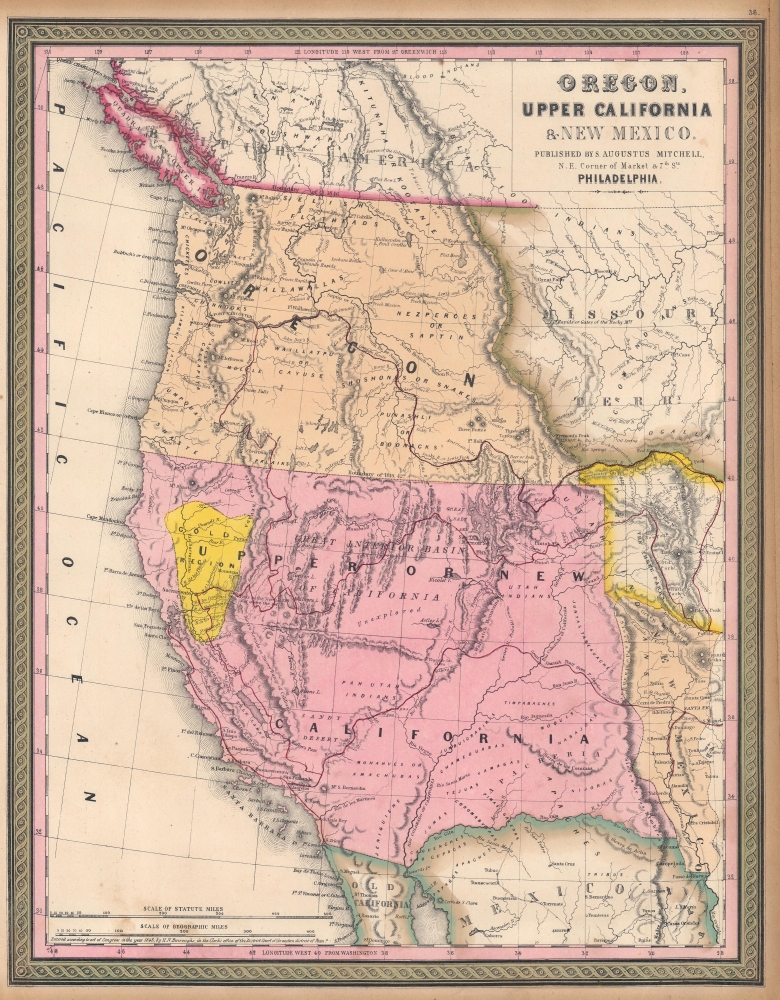This item has been sold, but you can get on the Waitlist to be notified if another example becomes available, or purchase a digital scan.
1849 Mitchell Map of California and Oregon, with Gold Region
CaliforniaGoldOregon-mitchell-1849-2
Title
1849 (undated) 17 x 12.5 in (43.18 x 31.75 cm) 1 : 6705600
Description
A Closer Look
Coverage embraces the Transmississippi from Vancouver to the Mexican border and from the Pacific to Texas. It follows the borders established by the 1848 Treaty of Guadeloupe Hidalgo, which formally ended the Mexican American War and ceded Upper California to the United States. It was first issued in 1846 and went through several states, this being the 2nd, and because of the addition of the California Gold Region and Fremont's cartography, is the most desirable.Emphasizing the California Gold Region
The California Gold region is highlighted in bright yellow and here appears as such for the first time. Mitchell reworked the plate late in 1849, the first major reworking since the original H.N. Burroughs engraving of 1845. The highlighted California Gold Region exists in only one plate, but appears in two editions of the atlas, late-1849 and early-1850. Late in 1850 the plate was reworked once again, under Cowperthwait, with a more sophisticated mapping of Nevada region, Utah and New Mexico delineated, and outline and coloring around the gold region removed. The highlighting of Fremont's route was also removed in this late-1850 edition.The Fremont Expedition
Also of significance is the highlighting of routes explored by the Fremont Expedition and the Great Spanish Trail. Although these exploratory routes appear on later editions of the map, it is only in this edition, issued just after Preuss' official map of the expedition, that they are so intensely highlighted. The map adds a wealth of detail from the Fremont Expeditions, particularly in the Great Basin, between Great Salt Lake and the Sierra Nevada Range, where Lake Carson and Walkers Lake appear for the first time. The cartographer has also added hills along Fremont River and sketched in the course of the Humboldt River.The California Gold Rush
The discovery of gold at John Sutter's mill by James Wilson Marshall (1810 - 1885) in January of 1848 was one of the most definitive moments in American history. Coming at the end of the Mexican-American War (1846 - 1848), the timing of the discovery could not have been more propitious. The combination of new seemly unlimited territory and the lure of gold led to a stampede of adventurers, prospectors, merchants, and homesteaders eager for a new life on the frontier. The Gold Rush was not limited to Americans crossing the Great Plains. European, Australian, and even Chinese immigrants rushed into California hungry for their part of the great strike. This Great Migration transformed the United States in the span of just a few years from a former colony into an expansive transcontinental nation on the cusp of becoming a world power.Publication History
This map was issued in the 1849 edition of the New Universal Atlas. It was the last edition of that atlas to be published by Mitchell prior to selling the plates and rights to the atlas to Thomas Cowperthwait in 1850.CartographerS
Samuel Augustus Mitchell (March 20, 1792 - December 20, 1868) began his map publishing career in the early 1830s. Mitchell was born in Bristol, Connecticut. He relocated to Philadelphia in 1821. Having worked as a school teacher and a geographical writer, Mitchell was frustrated with the low quality and inaccuracy of school texts of the period. His first maps were an attempt to rectify this problem. In the next 20 years Mitchell would become the most prominent American map publisher of the mid-19th century. Mitchell worked with prominent engravers J. H. Young, H. S. Tanner, and H. N. Burroughs before attaining the full copyright on his maps in 1847. In 1849 Mitchell either partnered with or sold his plates to Thomas, Cowperthwait and Company who continued to publish the Mitchell's Universal Atlas. By about 1856 most of the Mitchell plates and copyrights were acquired by Charles Desilver who continued to publish the maps, many with modified borders and color schemes, until Mitchell's son, Samuel Augustus Mitchell Junior, entered the picture. In 1859, S.A. Mitchell Jr. purchased most of the plates back from Desilver and introduced his own floral motif border. From 1860 on, he published his own editions of the New General Atlas. The younger Mitchell became as prominent as his father, publishing maps and atlases until 1887, when most of the copyrights were again sold and the Mitchell firm closed its doors for the final time. More by this mapmaker...
Horatio Nelson Burroughs (June 28, 1812 - August 23, 1896) was an engraver and later a banker based in Pennsylvania and active in the early 19th century. He was born in Washington Crossing, New Jersey. Burroughs' work first appears in conjunction with Henry Schenk Tanner and Samuel Augustus Mitchell (the elder). His name appears on the 1846 copyrights of many of Mitchell's earliest and most important atlas and pocket maps. Following 1846, Burroughs retired from engraving to become a banker, eventually becoming president of Commonwealth Bank. He married first Eleanor Douglas Mitchell (18?? - 1853), then, after her untimely death, her sister Caroline Mitchell (1818 - 1892), both daughters of map and atlas publisher Samuel Augustus Mitchell Sr. (1792 - 1868). Learn More...

